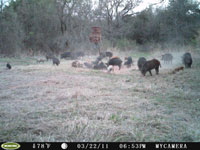
Hogfestation
Story by Campbell Decker and Photo by John Ammons
With the recent explosion in feral hog numbers across the state, landowners have become burdened with hogs’ inhabitation of the land. Damage by the hogs is widespread, costing farmers and ranchers hundreds, sometimes thousands, of dollars. Hogs are not only a threat to fences and crops, but people as well.
To help residents battle the number of hogs across the state, Texas AgriLife Extension is working toward educating the public on control methods. As with any animal species, population management is crucial to their survival. Population management techniques and methods must be applied to control Texas’ feral hog infestation.
Billy Higginbotham, a wildlife specialist for Texas AgriLife Extension Service. He is regarded as one of the state’s best educated and experienced personnel on hogs.
“Trapping is the first line of defense,” Higginbotham said.
More than three hundred years ago, early Spanish conquistadors presumably introduced hogs to Texas. They were originally brought as a source for meat and for sport hunting. During the fight for Texas a large number of livestock were released or abandoned due to the hostile environments statewide. It was not until after the conflicts between Texas and Mexico that settlers began coming to Texas again bringing new livestock.
In the early 1900s, the Russian boar was introduced by hunters for sport. Since that time Russian boars have adapted and bred with the European hogs to become permanent residents of Texas and surrounding states.
As a nongame, exotic and unprotected species, hogs can be hunted year round by any means or methods. There is no season or bag limit for feral hogs in Texas; however, a hunting license and landowner permission is necessary.
They can cause serious losses to agriculture in many different ways. Feral hogs are especially fond of agricultural crops such as corn, milo, rice, wheat, soybeans, peanuts, potatoes, watermelons and cantaloupe. This makes them a pest to any farming operation or family garden because they can diminish whole crops in one nighttime feeding. Larger boars with tusks tend to bust through the best of fences to gain access to forages.
“The legal control tools we have available to us at this time are shooting, trapping, snaring, and use of catch dogs,” Higginbotham said.
Ranging in numbers from five to 50, feral hogs travel in packs. Families usually consist of multiple sows and their offspring. Male boars are generally solitary and only join a pack during feeding and to reproduce. Feral hogs eat both plant and animal matter.
Feral hogs’ ability to repopulate quickly and adapt to many environments, combined with Texas’ large amount of undeveloped land, allows for hogs to become the perfect large pest. It is estimated that hogs cause more than $50 million in damages to agriculture alone each year.
“Approximately 134 million acres, or 79 percent of the state’s 170 million acres, represents feral hog habitat,” Higginbotham said.
Texas AgriLife Extension Services has shown through active population control, hogs’ damage to agriculture can be greatly limited. Effective trapping and hunting methods, combined with spreading education can help to keep numbers limited on private lands. With Texas being mostly private land, educating the public on control methods is the best defense. With consistent management efforts, damage from feral hogs can be reduced significantly.